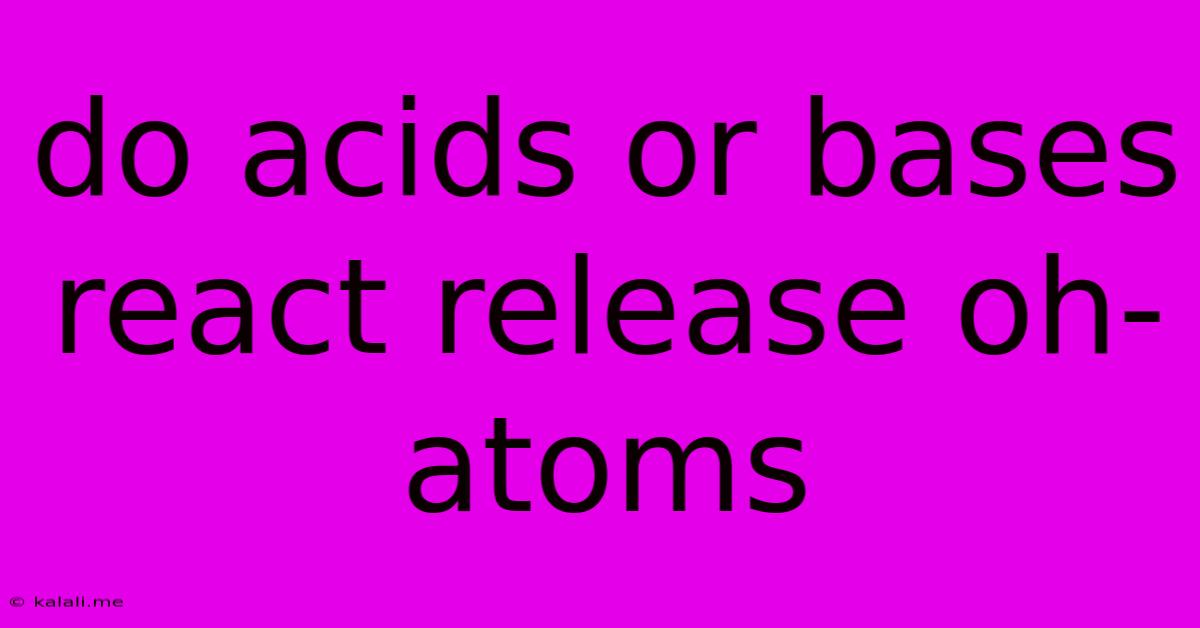Do Acids Or Bases React Release Oh- Atoms
Kalali
Jun 05, 2025 · 3 min read

Table of Contents
Do Acids or Bases React to Release OH⁻ Ions?
Meta Description: Understanding the chemical behavior of acids and bases is crucial in chemistry. This article clarifies which of these releases hydroxide (OH⁻) ions during reactions and explores the underlying principles. Learn about Arrhenius, Brønsted-Lowry, and Lewis acid-base theories for a comprehensive understanding.
Acids and bases are fundamental concepts in chemistry, defining a significant portion of chemical reactions and properties. A key characteristic often used to differentiate them is their behavior concerning hydroxide ions (OH⁻). But which one releases these negatively charged ions? The short answer is: bases release hydroxide ions (OH⁻).
However, understanding this requires a deeper dive into the different definitions of acids and bases. Let's explore the three major theories:
Arrhenius Definition
The Arrhenius definition, one of the earliest acid-base theories, defines acids as substances that increase the concentration of hydrogen ions (H⁺) in aqueous solutions, and bases as substances that increase the concentration of hydroxide ions (OH⁻) in aqueous solutions. This is the most straightforward definition and directly addresses our question. According to Arrhenius, only bases release OH⁻ ions. For example, when sodium hydroxide (NaOH) dissolves in water, it dissociates into Na⁺ and OH⁻ ions, increasing the hydroxide ion concentration.
Brønsted-Lowry Definition
The Brønsted-Lowry theory expands upon the Arrhenius definition. It defines acids as proton donors (H⁺) and bases as proton acceptors. This broader definition encompasses more substances than the Arrhenius theory. While a strong base will still release OH⁻ ions, a Brønsted-Lowry base doesn't necessarily produce OH⁻ ions directly. It can accept a proton, often leading to the formation of water which contains an OH⁻ ion. For example, ammonia (NH₃) acts as a Brønsted-Lowry base by accepting a proton from water, resulting in the formation of ammonium ion (NH₄⁺) and hydroxide ion (OH⁻). The key difference here is that the OH⁻ ion is not directly released from the base itself, but rather formed through a reaction.
Lewis Definition
The Lewis theory provides the broadest definition of acids and bases. It defines acids as electron-pair acceptors and bases as electron-pair donors. This definition goes beyond proton transfer and encompasses reactions that don't involve H⁺ or OH⁻ ions directly. While it doesn't explicitly focus on OH⁻ release, Lewis bases can participate in reactions that ultimately lead to the formation of hydroxide ions in the solution, albeit indirectly.
Summary Table: OH⁻ Ion Release
| Theory | Acid Definition | Base Definition | OH⁻ Ion Release from Base? |
|---|---|---|---|
| Arrhenius | Increases H⁺ concentration | Increases OH⁻ concentration | Yes |
| Brønsted-Lowry | Proton donor | Proton acceptor | Indirectly, often through reaction |
| Lewis | Electron-pair acceptor | Electron-pair donor | Indirectly, often through reaction |
In conclusion, while the Arrhenius definition clearly states that only bases release OH⁻ ions, the Brønsted-Lowry and Lewis theories show that OH⁻ ion formation can occur indirectly through reactions involving bases. The direct release of OH⁻ is a defining characteristic of Arrhenius bases, but the broader definitions highlight the complex interplay of acids and bases in various chemical processes. Understanding these different perspectives provides a more comprehensive understanding of acid-base chemistry.
Latest Posts
Latest Posts
-
How To Use Too In A Sentence
Jun 06, 2025
-
What Is Jasher In The Bible
Jun 06, 2025
-
What Prophecies Did Jesus Not Fulfill
Jun 06, 2025
-
Advantages Of Epoxy Paint On Walls
Jun 06, 2025
-
Address Format Where To Put Commas
Jun 06, 2025
Related Post
Thank you for visiting our website which covers about Do Acids Or Bases React Release Oh- Atoms . We hope the information provided has been useful to you. Feel free to contact us if you have any questions or need further assistance. See you next time and don't miss to bookmark.